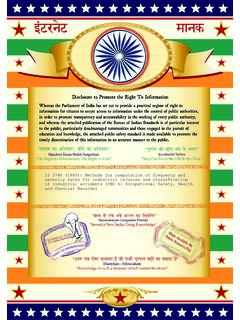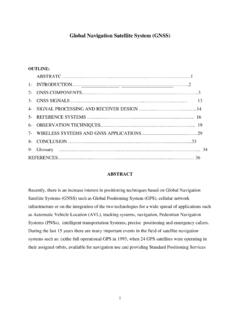Transcription of RESEARCH METHODS 1: FREQUENCY DISTRIBUTIONS
1 RESEARCH METHODS 1 Handouts, Graham Hole,COGS - version , September 2000: Page 1:DESCRIPTIVE STATISTICS - FREQUENCY DISTRIBUTIONS AND AVERAGES:Inferential and Descriptive Statistics:There are four main stages in doing RESEARCH : designing a study, collecting the data, obtainingdescriptive statistics and perhaps performing some inferential are a set of tools for obtaining insight into a psychological phenomenon. Descriptivestatistics summarise the data, making clear any trends, patterns etc. which may be lurking withinthem; they consist of visual displays such as graphs, and summary statistics such as statistics attempt to make inferences about the parent population on the basis of the limitedsamples actually obtained. The term inferential statistics is usually reserved for the various statisticaltests used for comparing two or more groups of subjects within an experiment, etc.
2 (Although in effect,most of statistics in psychology involves a process of trying to make inferences about humanity on thebasis of a few undergraduate subjects!)Samples and Populations:In statistics, the terms sample and population have special meanings. A sample is a limitedsubset from a population, and a population is the entire set of things under consideration. Whatconstitutes a population will vary according to what it is you are trying to make extrapolations to:usually the population to which we are trying to generalise from our sample consists of the entirehuman race. However, if you are interested only in making claims about the behaviour of three-toedAmazonian sloths, then you might be able to get access to the entire population of sloths if thereweren't very many of them in existence.
3 Normally, we have to obtain data from a limited sample ofsubjects because it is impossible to obtain data from the entire population to which they of Data:It's important to know what kind of data you are dealing with, as certain statistics can only beused validly with certain kinds of data.(a) Nominal (categorical) data:Numbers are used only as names for categories. Therefore they are not really acting asnumbers, but just serving as labels. If the numbers can be replaced by letters or names, then you aredealing with nominal data. So, if you had four groups, you could label them "1", "2", "3" and "4", but itwould mean just the same as if they were entitled "A", "B", C, and "D". You cannot do any statistics orarithmetic on nominal data, in just the same way as you cannot add together A and B.
4 The numberson footballers' jerseys are the classic example of nominal data: adding together players at positions 1and 2 does not give you the player at position 3!(b) Ordinal (rank) data:Things can be ordered in terms of some property such as size, length, speed, time , successive points on the scale are not necessarily spaced equally apart. To rank Grand Prixracers in terms of whether they finish first, second, third, and so on, is to measure them on an ordinalscale: all that you know for certain is the order of finishing - the difference between first and second-placed finishers may be quite different from the difference between those placed second and third. Inpsychology, most attitude scales ( , seven-point scales which run from "1" for "completely disagree"through to "7" for "completely agree") are making measurements on an ordinal scale.
5 (c) Interval data:These are measured on a scale on which measurements are spaced at equal intervals, but onwhich there is no true zero point (although there may be a point on the scale which is arbitrarily named"zero"). The classic examples are the Fahrenheit and Centigrade temperature scales. On theCentigrade scale, a rise of "one degree" represents an increase in heat by the same amount, whetherone is talking about the shift from 5 degrees to 6 degrees, or from 90 degrees to 91 , because the zero point on the scale is arbitrary, one cannot make any statements aboutratios of quantities on the scale: thus it is not permissible to say that 26 degrees is twice 13 degrees orhalf of 52 degrees.(d) Ratio data:This scale is the same as the interval scale, except that there is a true zero on the scale,representing a compete absence of the thing in question which is being measured.
6 Measurements ofheight, weight, length, time are all measurements on ratio scales. With this kind of scale, the intervalsare equally spaced and we can make meaningful statements about the ratios of quantities , an increase in length between 9 inches and 10 inches is the same as an increase in lengthbetween 90 inches and 91 inches; and additionally, we can say that 6 inches is twice 3 inches, andResearch METHODS 1 Handouts, Graham Hole,COGS - version , September 2000: Page 2:half of 12 concept of levels of measurement may seem rather abstract and confusing now, but it willprove important in helping us to decide which statistics are appropriate for our data. For example,some statistical tests can only be used with nominal data, and others can only be used with interval orratio the data, by using FREQUENCY DISTRIBUTIONS :The normal consequence of doing a psychology experiment is to end up with a score or set ofscores for each of the individuals that took part in the experiment.
7 The first thing we need to do is tosummarise these data in some way, so that we can see the "wood" for the "trees" - in other words, sothat we are more likely to spot any trends or effects that are lurking within all those numbers. Imaginewe were interested in how well psychology students coped with doing a statistics exam. For eachstudent, we might have their exam score. We might want the answers to various questions: forexample, how well people were doing generally; what the highest and lowest scores were; within whatrange the bulk of the scores fell; etc. Presented simply as a table of unprocessed numbers, answeringquestions like this would be difficult. One of the goals of statistics is to make it easier to see what'sgoing on in your data.
8 So, the first step might be to construct a FREQUENCY distribution of the scores:we could simply count how many people obtained each of the scores that it was possible to is an improvement over our original unordered data-set, but things could be better: weare still bogged down in the details of the data. To get a better picture of the overall trends that arepresent, we could produce a grouped FREQUENCY distribution of the scores: we could construct anumber of categories, each of which corresponded to a range of scores. We could then count howmany scores fell into each of these categories, or class intervals. Thus, instead of recording that foursubjects scored 52, two subjects scored 53 and one subject scored 54, we could summarise thesedata by noting that seven subjects scored between 52 and 54.
9 The number of class intervals is fairlyarbitrary, but most statisticians suggest between 10 and 20 gives the best results: too few, and youlose too much information about what's going on in your set of numbers. Too many categories, andyou are back to where you started, unable to see the overall picture because you are bogged down inthe excessive we might want to compare FREQUENCY DISTRIBUTIONS which are based on differenttotals. Imagine that 50 people take a statistics exam one year, and 100 take it the next year, but inboth years 25 people fail. 25 failures out of 50 is a lot more serious than 25 failures out of 100. In theformer case, half of the students have failed, whereas in the latter case only a quarter have failed!
10 How can we compare FREQUENCY DISTRIBUTIONS when they are based on different totals? The solution isto turn our "raw" frequencies into relative frequencies. To turn a raw FREQUENCY into a relativefrequency, divide the raw FREQUENCY by the total number of cases, and then multiply by 100. Thus(25/50)*100 = 50%, and (25/100)*100 = 25%. By converting frequencies to relative frequencies in thisway, we can more easily compare FREQUENCY DISTRIBUTIONS based on different totals. If you display datain the form of relative frequencies ( , as percentages of the total), ideally you should also show theraw frequencies, so that readers are aware of how many cases your percentages are based on. At thevery least you should show the total number of cases, so that readers can work out for themselveshow large a sample your percentages are based on.

















